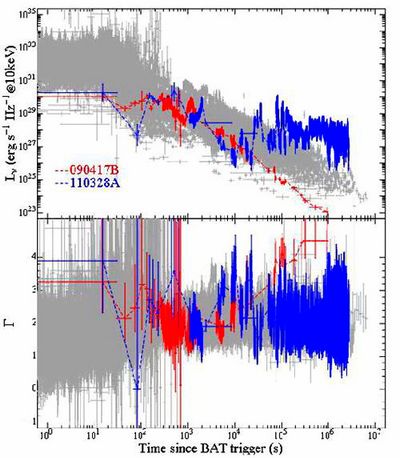
Fig. 1: Evolution of the spectral luminosity at 10 keV of Sw 1644+57/GRB 110328A together with GRB 090417B (red) and other 137 long GRBs (gray) in their rest frames (from Shao et al. 2011)
(image by FAN Yizhong)
SW 1644+57/GRB 110328A was discovered by the Swift satellite at 2011 March 28 12:57:45 UT. It is coincident with an optical source at redshift z=0.353. The isotropic energy of total X-ray and gamma-ray is ~1E53 erg and the luminosity of the flaring X-ray afterglow is ~1E46-1E48 erg/s, both comparable to regular Gamma-Ray Bursts (GRBs) and establishing its initial name, GRB 110328A. However, the source was detectable and variable in Burst Alert Telescope (BAT) more than 40 hours after the initial trigger (BAT re-triggered for quite a few times), with peak brightness in the order of 200 mCrab. Moreover the flaring X-ray plateau held up to >40 days. These features are rather peculiar and have not been reported in any GRBs before, rendering Sw 1644+57 one of the most exciting astrophysical discoveries made in 2011 (see also http://www.nasa.gov/topics/universe/features/star-disintegration.html).
Dr. SHAO Lang and ZHANG Fuwen, together with Prof. FAN Yizhong and WEI Daming carried out a timely research on this remarkable cosmological X-ray outburst. They found out that the early-time (<0.1 day since the trigger) X-ray emission of Sw 1644+57 resembles some gamma-ray bursts, say, GRB 090417B. But the late-time flaring X-ray plateau lasting >40 days makes it unique (see Fig.1). They examined the possibilities that the outburst is a super-long GRB powered either by the fallback accretion onto a nascent black hole or by a millisecond pulsar, and found out that these two scenarios can address some but not all of the main observational features. They then focused on the model of tidal disruption of a (giant) star by a super-massive black hole, in which some tidal-disrupted material forms a well-extended accretion-disk surrounding the central black hole and energetic X-ray bursts are produced in the accretion process. The mass of the tidal-disrupted star was estimated to be > a few solar masses and a simple/straightforward argument for a magnetic origin of the relativistic outflow had been presented. The central super-massive black hole likely has a mass ~1E6 solar masses while GRB 090417B-like events plausibly have a typical mass ~ a few - tens solar masses. The similarity between the early (t<0.1 day) X-ray emission of Sw 1644+57 and that of GRB 090417B strongly suggests that very different central engines can produce rather similar X-ray outbursts in a selected time interval, possibly via the same kind of initial energy-extraction and late-time-energy-dissipation processes. The work by SHAO Lang, ZHANG Fuwen, FAN Yizhong (corresponding author) and WEI Daming, accepted by The Astrophysical Journal Letters in 3 weeks, has been published online (http://iopscience.iop.org/2041-8205/734/2/L33).
|
